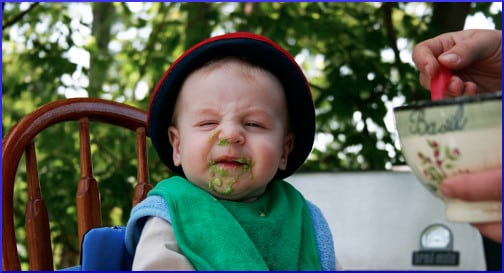
Today we take a closeup look at where eating starts, and where, by logical extension, most obesity starts — the human mouth. Mary Roach wrote a lengthy report for The New York Times about Wageningen, an area in the Netherlands where almost 15,000 food scientists are employed by research labs and universities. They work tirelessly to figure out food, aided by such institutions as the Restaurant of the Future, which is equipped with hidden cameras.
Interesting for those who deal with children are the designations of the safest and the most dangerous foods. For small kids, three edible items are the most lethal, because of their round shapes. If a grape, a piece of hot dog, or a round candy “goes down the wrong way,” it fits snugly into the trachea and prevents air from being inhaled.
Roach’s report says:
“Immature swallowing coordination” is the reason 90 percent of food-related choking deaths befall children under 5. Also contributing: immature dentition. Children grow incisors before they have molars; for a brief span of time they can bite off pieces of food but cannot chew them.
Stuff that as been mechanically pre-chewed, like conventional baby food, is the safest. It is also the most boring. Researchers have also come to such conclusions as this:
Mushy food is a form of sensory deprivation. In the same way that a dark, silent room will eventually drive you to hallucinate, the mind rebels against bland, single-texture foods, edibles that do not engage the oral device.
The oral device is the complex of teeth, tongue, lips, cheeks, and saliva that collectively transform matter from recognizable food into a bolus, a wad that has been rendered into a swallowable state. Indeed, much of the research involves asking human subjects to spit out whatever they were just on the verge of swallowing.
Dysphagia
Successful bolus formation and swallowing are crucial, and dependent on “a highly coordinated sequence of neuromuscular events and reflexes.” When a bolus is ready to swallow, the larynx is supposed to move in a way that lets it down the esophagus and keeps it out of the trachea.
Dysphagia is the medical term for inability to do these things properly, and can be a side effect of a degenerative process that affects the nerves, or other conditions. When food does go down the windpipe, the blockage of oxygen can of course be fatal. If the person lives, any bacteria aspirated into the lungs can cause pneumonia.
What the Experts Say
Roach discusses the work of Dr. Andries van der Bilt, who seems to be the world’s leading authority on “masticatory performance,” or chewing. The jaw muscles are the body’s strongest, in terms of “pressure per single burst of activity.” Yet the apparatus is incredibly sensitive, as it must be, to prevent people from pulverizing their own teeth. The mouth is a non-mechanical food processor, and the way a person chews is compared to a fingerprint, although possibly not quite as unique.
A fascinating angle that the journalist looked into is the science of crispy-crunchy, which Dr. Ton van Vliet has been studying for seven years. Apparently, love of crunchiness is instinctive, because it warns us whether an apple or carrot is fresh. Limp fruit is old and maybe rotting. When it comes to crunchy snacks, their cells are filled with air rather than water. But when the cell walls are breached, we experience the same sensation of “brittle fracture” and an audible noise, which is where the thrill of crispiness originates.
The writer quotes Dr. Van Vliet:
To get this noise, you need crack speeds of 300 meters per second. The speed of sound. The crunch of a chip is a tiny sonic boom inside your mouth.
With a personality quirk reminiscent of Star Trek‘s Mr. Spock, Dr. van Vliet himself dislikes chips and other crunchy snacks, Roach says, and has never sampled any of the Restaurant of the Future’s fare.
Your responses and feedback are welcome!
Source: “The Marvels in Your Mouth,” NYTimes.com, 03/25/16
Image by kellinahandbasket

 FAQs and Media Requests:
FAQs and Media Requests: 












One Response